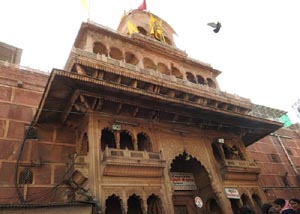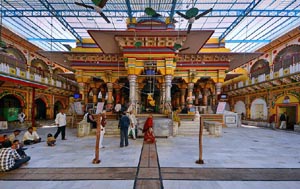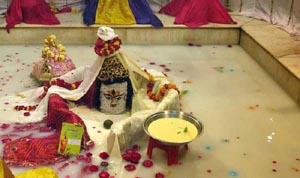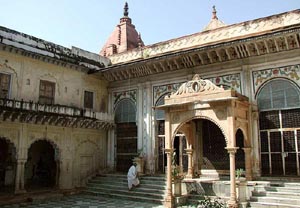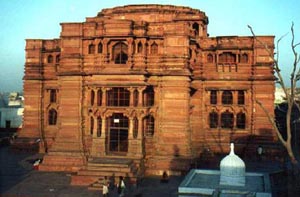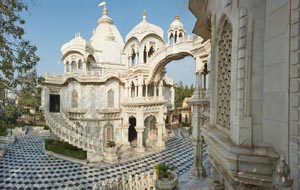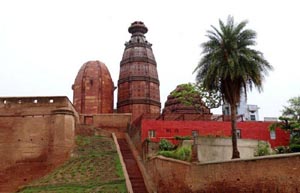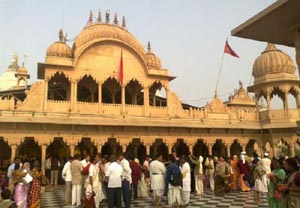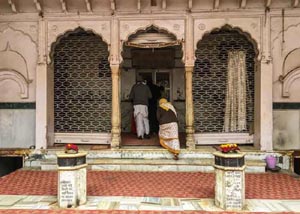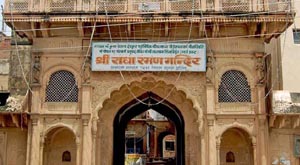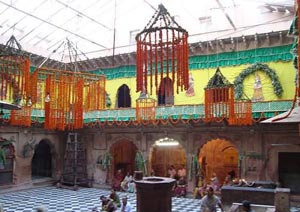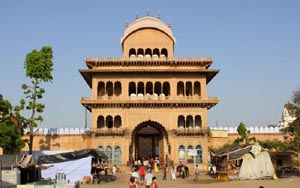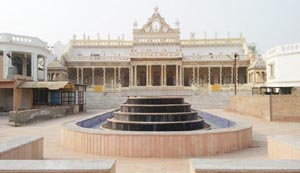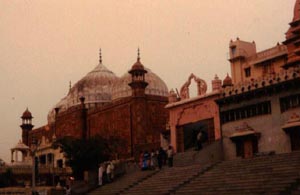Mathura Temples
List of Names & Information on Famous Hindu Temples in Mathura District
Here you can find list of names and information (like history, architecture & facts) on ancient / old Hindu temples in Mathura, India. These Famous temples in Mathura district are most visited and most sought after best tourist places. You can also find photos of Mathura temples / mandir.
Bankey Bihari Temple is thronged by considerable number of devotees every day. There are several religious celebrations are held in Bankey Bihari Temple and one of the most popular is Jhulan Yatra. It is swing commemoration of lord Krishna. On this occasion various silver plated and silver designed wings are demonstrated.
Dwarkadhish Temple is an irresistible portion of religious memorials in Mathura. This temple is dedicated to lord Krishna and thus in the manner of other temples of Krishna, Janmasthami is the primary festival of Dwarkadhish Temple. This festival is celebrated with great passion and devotion. Apart from Janmasthami, other big festivals in Dwarkadhish Temple are Jhulan Yatra, Holi and Diwali. During these celebrations, the entire environment of Dwarkadhish Temple displays splendour and sumptuousness.
Gopeshwar Mahadev Temple enshrines lord Shiv in the form of Gopeshwar, who appears as a big Shiv Linga. Gopeshwar in the temple is dressed in asaree and is appears in its female characteristics. During morning time, several devotees come to Gopeshwar Mahadev Temple in order to see the lord. Some of the devotees also bath him with either milk or water or honey. Devotees also offer worship and pray to the god. It is believed that visiting this temple can remove any pains and wrenchesin life.
The idols in Gopinath Templeare worshipped by MadhuPanditGoswamiwho was one of the close associates of guru Chaitanya. He was also a close loving companion of six other Goswamis in Vrindavan. According to legend, the idol of Gopinathji was lost for long period of time. However, one great devotee named Paramananda Bhattacharya revived the lost idol. Radhanath Swami defined the story behind the re-emergence of Gopinathji throughout his journey to Vrindavan.
Govind Dev Temple is regarded as king Man Singh's best known construction plan. The temple was the biggest construction created in Northern India in 12th century. It is believed that in the year 1573, King Akbar visited Vrindavan and on the basis of tradition, Hindu emperors convoyed him and attained his authorisation to create Govind Dev Temple. At present, Govind Dev Temple is empty and behind the temple, there is a small Govind Dev Temple where replica of original deity of lord Govinda is worshipped.
The immediate objective of the creation of ISKCON Temple was to promote the teachings of Bhagwad Gita as well as the Vedic scriptures and hence, to create an apparent awareness about lord Krishna in the mind of devotees. The aim of ISKCON Temple is to direct people towards a simple yet clean and otherworldly life. ISKCON Temple belongs to Vaishnavism, which is a religious tradition, created on the basis of the instructions of Gita.
There is quite interesting legend which is related with the creation of Madan Mohan Temple. Once there was a trader in Vrindavan named Ram Das Kapoor. During the voyage, his ship which was full with considerable amount of tradable goods, went aground. This was quite disastrous for Ram Das where he would have confronted severe monetary losses. After getting guidance from Sanatana Goswami, he prayed to Lord Madan Mohan for assistance.
The idols of Radha Damodara in the temple were established by Rupa Goswami, an Indian religious teacher who later gave them to his follower Jiva Goswami for worshipping. In later phase, owing to the terror of Mughal Emperor Aurangzeb, the idols of Radha Damodar was transferred to Jaipur for certain period of time. Afterwards, when the social situation become favourable, the idols were brought back to Vrindavan in 1739 CE.
The key idols of Radha Gokulananda Temple are Radha Vinodawhich is worshipable deities of Thakur Vishvanath Chakraborty. Devotees from all over India, pay a visit in order to observe the deities resided in Radha Gokulananda Temple. It is believed that Thakur Vishvanath Chakraborty who arrived as successive disciple of Lokenath Gosvami, established the worship of Radha Gokulananda in Vrindavan.
Radha Raman Temple organises various religious festivals for example, Jhulan Yatra. This festival occur at the beginning of rainy season, i.e. during the month of July or August. On this occasion, the small idols are brought out in the courtyard and organised in a beautiful gold plate. The other popular event in Radha Raman Temple is Janmashtami which is celebrated during the month of August or September. On this festival, thousands of devotees worship lord Krishna.
Every day several devotees capitulate themselves in the feet of Radha Vallabha. In the fortnight, religious celebration Sanjhitakes place in Radha Vallabha Temple with the temple custom. On that day, the gurus describe the verses of Sanjhi. For the first ten days of fortnight, the idols are decorated with flower and from 11th day to 15th day of dark fortnight, the idols are decorated with coloured powders. The flowery decorations of Radha Vallabha Temple include several acts of Krishna and Radha, known as Leelas.
Apart from lord Vishnu, there are multiple sides of Rangji Temple comprising ones which is devoted to Vaishnava saints named Alwars, Tirupati Balaji and Ananta Sayanam. Furthermore, god Narasimha, lord Ram, Laxman and Sita, lord Venugopala and lord Ramanujacarya are also worshipped in Rangji Temple. The temple is maintained by the priests of lord Sampradaya, which starts from goddess Laxmi, the deity of fortune.
Shahji Temple is a very creative temple. The deity reigning and consecrating the temple has its eternal massage of religious halt, marking the gallant end of human life. Shahji Temple possesses an amazing Durbar Hall of Radha Raman which is also known as Vasanti Kamra. The room is completely designed with yellow colour. Furthermore, there are several beautiful Belgium chandeliers in this room.
Holi is the other popular festival in Shri Krishna Janmabhoomi. The celebration of Holi in Shri Krishna Janmabhoomi occurs in old-fashioned way. On this occasion, the entire temple is decorated with colourful design. Furthermore, several worshipful and religious songs are also chanted in this festival in Shri Krishna Janmabhoomi temple.
- Andhra Pradesh Temples
- Assam Temples
- Bihar Temples
- New Delhi Temples
- Goa Temples
- Gujarat Temples
- Jammu and Kashmir Temples
- Karnataka Temples
- Kerala Temples
- Madhya Pradesh Temples
- Maharashtra Temples
- Odisha Temples
- Punjab Temples
- Rajasthan Temples
- Sikkim Temples
- Tamil Nadu Temples
- Telangana Temples
- Uttar Pradesh Temples
- Uttarakhand Temples
- West Bengal Temples
